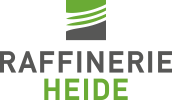Cross-sector partnership: Green hydrogen and decarbonization on an industrial scale
A cross-industry partnership called “Westküste 100” has been formed in Schleswig-Holstein by EDF (Germany), Holcim Germany, Open Grid Europe, Ørsted, Raffinerie Heide, Stadtwerke Heide and thyssenkrupp Industrial Solutions – together with the Heide region development agency and the West Coast University of Applied Science (FHW). The aim is to produce green hydrogen from offshore wind energy and utilize the waste heat generated in the process. The hydrogen will then be used to produce climate-friendly aviation fuels and fed into gas grids. Unavoidable CO2 from a local cement plant will be used in the fossil-free production of aviation fuel. What is special and innovative about this real-world laboratory project is the integration of different material cycles within an existing regional infrastructure.
The Westküste 100 project was submitted as a proposal for the “Real-world laboratories of the energy transition” competition of the Federal Ministry of Economics at the beginning of April 2019. Real-world laboratories offer the opportunity to accelerate the transfer of technology and innovation from research to practice, enabling technical and non-technical ideas and innovations to be developed and tested under real conditions and on an industrial scale.
Jürgen Wollschläger, managing director of Raffinerie Heide and project coordinator: “We have a clear vision in the Westküste 100 project team: the partners wish to focus on long-term collaborations, ranging from the generation of green electricity to the production of synthetic hydrocarbons, and so create the nucleus for sustainable business models for the transition to renewables and decarbonization.”
Details of the proposal
Within the five-year project period, an electrolysis plant with a capacity of 30 megawatts is to be installed initially. It will provide information on the operation, maintenance, control and grid flexibility of the equipment in preparation for the next scale-up step, which could be a 700 MW electrolysis plant fed with electricity from an offshore wind farm.
The approach of the Westküste 100 real-world laboratory is holistic: The renewable energy generated with the help of wind power will be used at the Heide refinery to produce green hydrogen by electrolysis. In the future, a hydrogen grid will be built between the refinery, the municipal utilities, a cavern system and the existing natural gas grid using a newly developed pipeline technology. The cavern system for hydrogen storage will convert the available wind energy into a continuous stream of hydrogen for industrial use.
The project will also test whether the oxygen produced during electrolysis could be fed into the combustion process of a local cement plant with the aid of the “Oxyfuel process”. This would also significantly reduce the cement plant’s nitrogen oxide (NOx) emissions. The carbon dioxide (CO2) produced in the cement plant could be used in the refinery together with the green hydrogen as a raw material for the production of synthetic hydrocarbons (aviation fuel or chemical feedstocks such as methanol). This would be an important contribution to the decarbonization of the cement industry. In the aviation sector – the fastest-growing transport sector in Germany and the EU – a synthetic green fuel would represent a further breakthrough in decarbonization. An additional plus point: the process heat produced could be extracted to a modified heat network and used, for example, in an industrial park.
For more information on the project please visit www.westkueste100.de.

